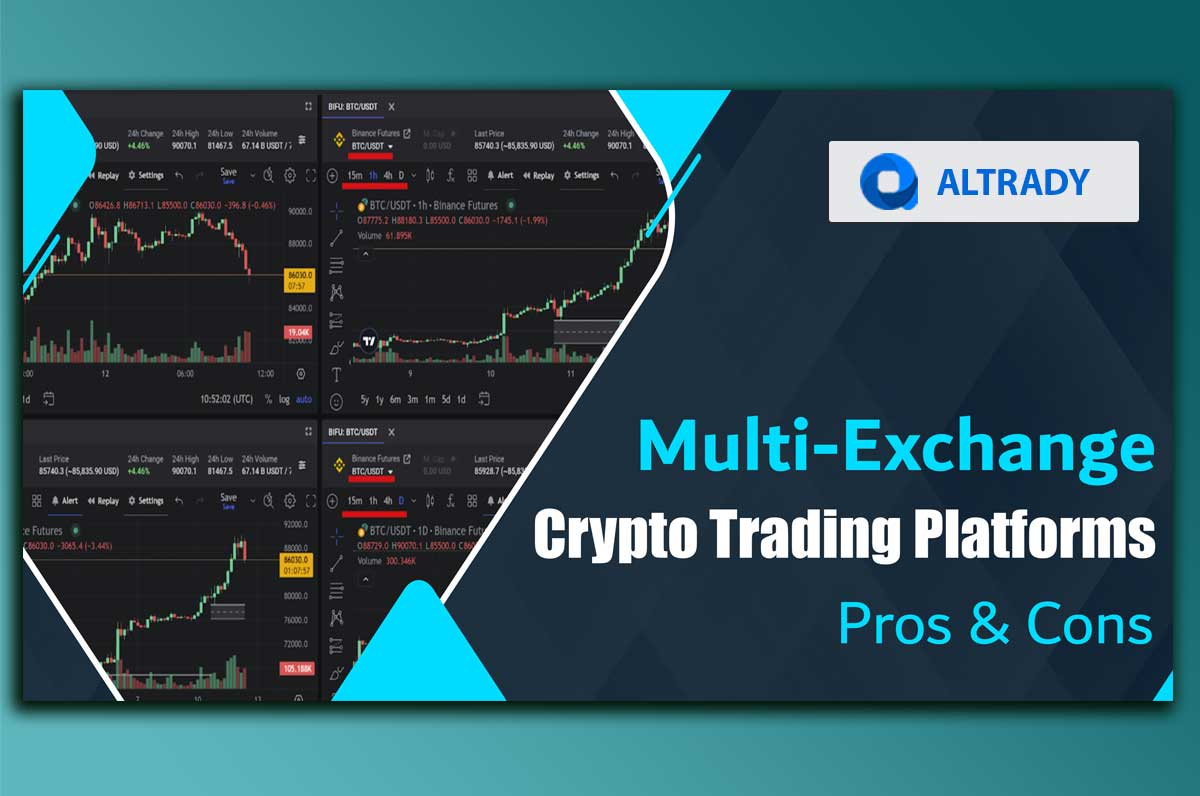Black Friday is loading…
Get 40% off with Altrady’s yearly plan and take the lead.
.svg)
.svg)
.svg)
.svg)
.svg)
.svg)
.svg)
.svg)
.svg)
.svg)
.svg)
.svg)
.svg)

Since exchanges rose and offered trading solutions, specialized trading platforms also took action in the cryptocurrency sphere. For crypto traders, multi-exchange trading platforms offer distinct advantages such as access to diverse assets and accounts interconnected, arbitrage opportunities, and enhanced tools. However, they also may come with challenges related to complexity, security, and costs. This article dives into relevant pros and cons that traders need to consider.

Multi-exchange crypto trading platforms have emerged as a popular solution for traders seeking to maximize their opportunities in the face of market volatility. These platforms gather features that help traders optimize strategies and whole trading systems, from speculative approaches to mid-term and long-term crypto holdings.
A multi-exchange allows users to trade across multiple exchanges from a single interface streamlined to smooth the strategic process and improve the trading experience. In a multi-exchange trading terminal, traders can manage all their accounts to overcome typical hassles associated with moving assets from one exchange to another or lacking methods to track progress and growth on all the strategies implemented.

Furthermore, multi-exchange platforms also perform as broader trading software. For example, a platform like Altrady enables traders to interconnect accounts. However, it provides operators with advanced trading solutions to execute trade ideas, manage positions and risks, study analytics, use algorithmic and quantitative systems through bots, etc.
Within all the possibilities revolving around these platforms, we can point out the following features as integral solutions for specific needs:
Typically, the unified interface of multi-exchange platforms offers a single user-friendly interface that converges data from various exchanges. This can save time and reduce the complexity of managing multiple accounts, making it easier for traders to keep track of their positions and market trends.
Up to this point, it is worth mentioning that, as with any other aspects involving trading, pros and cons weigh on multi-exchange platforms, and traders should not overlook them.

One of the most notable advantages of using a multi-exchange platform is trading diverse cryptocurrencies since different exchanges often list different tokens, and a multi-exchange platform provides traders access to a broader selection than they might find on a single exchange.
This amplification allows traders to seize opportunities and diversify their portfolios more effectively while exploring and adopting tokens rapidly as the first exchanges list them.
Price discrepancies between exchanges can present arbitrage opportunities for traders. By simultaneously buying a crypto coin at a lower price on one exchange and reselling it at a higher price on another, traders can capitalize on these differences. This is the basis for arbitrage strategies.
Multi-exchange platforms enable quick execution of these trades, generally using algorithmic systems that enhance potential profit margins. Bot trading plays a vital role in this type of procedure.
As more market participants spread across various platforms, traders may find better price movements and execution, which means that trading across multiple exchanges usually leads to increased liquidity.
This can be especially beneficial during high-volatility periods, where accessing liquidity quickly is crucial.
Many multi-exchange platforms cross the edge of simplicity and offer advanced trading tools, including charting options, analysis features, and automated trading capabilities.
This can empower traders to implement more sophisticated strategies and manage their portfolios effectively. For example, using innovative stop-loss and take-profit orders that typical exchanges might not provide.

Although the unified interface offers comfort, navigating multiple exchanges can also add a layer of complexity to the trading experience.
Traders might need to learn new fee structures, trading rules, and withdrawal limits associated with each exchange, which can be overwhelming.
Using multiple exchanges increases potential security concerns. Each exchange has unique security measures and anti-hack processes, and traders must consider the practices and systems they employ to protect their accounts.
The risk of breaches or hacks increases as the number of platforms used grows, and holding funds across multiple exchanges might complicate asset management if the chosen multi-exchange platform lacks proper features considering this con.
Although exploiting arbitrage opportunities can sound appealing, the costs associated with transferring funds between exchanges can affect profits. Transaction fees, trading commissions, and potential withdrawal fees can add extra costs, reducing the overall gains from trading between platforms.
By utilizing a multi-exchange platform, traders may become dependent on the service provider’s reliability and performance. Any downtime, outages, or technical issues can hinder trading abilities, leading to potential financial losses.
Different exchanges operate under various regulatory environments. For example, Binance US is a different platform than Binance Worldwide regardless of belonging to the same brand.
When trading across multiple platforms, traders may inadvertently encounter legal complexities, especially regarding tax implications or regulatory compliance, depending on their jurisdiction.
As with any trading approach, traders must evaluate the pros and cons regarding any trading proposal and devise strategies that align with their trading goals. Ultimately, choosing a multi-exchange platform should be based on thorough research and a clear understanding of its operation.
Altrady is a crypto trading platform with multi-exchange integration features where beginners and professional investors manage assets across multiple accounts simultaneously, seizing algorithmic, automation, and bot functionalities. Sign up for a free trial account today.